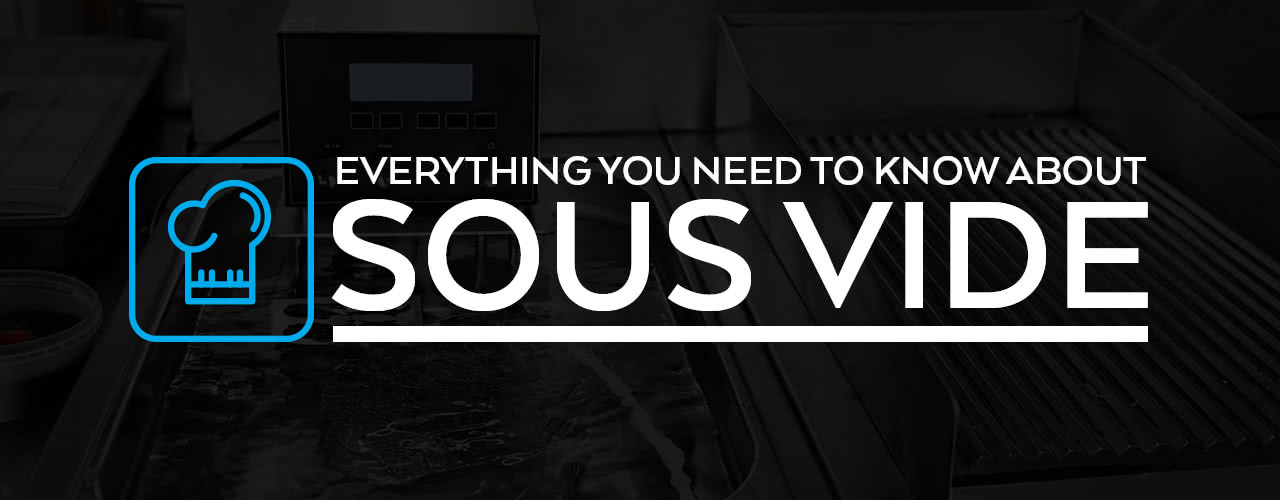Benefits of Sous Vide Cooking (Infographic)
4 Min Read By WebstaurantStore
Despite its humble roots, sous vide cooking has become one of the most celebrated ways of preparing food in commercial kitchens. Part of its popularity is due to the fact that it doesn’t require expensive equipment and can be performed by any member of your staff. If you’re looking for a consistent, easy, and energy-efficient method to prepare food at your restaurant, sous vide is the perfect choice.
If you’re interested in learning about sous vide cooking and incorporating this popular food preparation method into your restaurant, keep reading to learn about the benefits of sous vide, the equipment you’ll need, and how to use it to cook a variety of foods.
What is Sous Vide?
Developed in the mid-1970’s by a French chef, sous vide cooking is now a fixture in many commercial kitchens. Defined as “under vacuum,” sous vide is the process of slow-cooking vacuum sealed food with water set to a specific temperature. This relatively foolproof method will cook everything from steak to fruit and can be executed by any member of your staff. With the proper equipment and basic technical knowledge, your restaurant will soon be producing delicious sous vide dishes.
1. You Can Set It and Forget It
Cooking sous vide gives you the freedom to vacuum pack your food, place it in water, set the temperature, and walk away. Unlike traditional cooking methods where you have to watch and check on your food, items prepared using sous vide will cook to perfection and keep your chef’s hands free for other tasks. Your food will be held at a consistent temperature for long periods of time, and the texture and quality of your ingredients will remain intact. All of these factors make sous vide perfect for busy, high-volume kitchens or foodservice businesses that prefer to prepare food in advance.
2. Overcooking is Virtually Impossible
Another benefit of sous vide cooking is that it is virtually impossible to overcook your food. Sous vide cooks by bringing food up to the water bath’s exact temperature, so your ingredients will be unable to cook at a higher degree than the water’s specified temperature. The immersion circulator also makes it impossible for the water to cool beyond the set temperature, which leads to even and consistent cooking every time. Your food will also retain its moisture and tenderness due to the use of water as a cooking medium. Keep in mind that meat cooked sous vide-style will not brown or crisp, but you can easily achieve this by pre-searing or quickly applying a finishing sear to the food.
3. Reduced Risk of Contamination
The length of time it takes for foods to cook via sous vide also practically eliminates the risk of contamination, as the water essentially pasteurizes your food.
4. Better Taste
Another benefit of cooking via sous vide is that foods retain more of their nutrients and vitamins than ingredients cooked through more traditional methods. Similarly, natural juices remain trapped in the bag with your food, which leads to a marinating effect and enhances their taste.
Necessary Equipment
The first piece of equipment you’ll need to cook sous vide is an immersion circulator, which will keep your cooking water at a constant temperature. Immersion circulators also feature adjustable clamps that easily attach to your water bath. You can use a plastic food box or any storage tub to hold the water you’ll use to sous vide.
You’ll also need a commercial vacuum sealer and vacuum sealer bags. To package your food, simply place it into the bag, use the machine to suck out any extra air, and seal it tightly. Most vacuum packaging bags are made of polyethylene, which is considered a safe plastic. Be sure to avoid cheaper plastic wraps, though, which are often made of PVC and can leach chemicals into your food. At this point, you are ready to place your food into the water bath and set the cooking time and temperature.
What Can I Cook Using Sous Vide?
While sous vide works best for cooking meat and fish due to their lower required cooking temperature, you can also use sous vide to cook a variety of other foods. These include (but are not limited to) eggs, french fries, vegetables, fruits, and infused alcohols and oils. If you’re looking for sous vide recipes or cookbooks, we recommend the following:
- Thomas Keller’s Under Pressure: Cooking Sous Vide
- Jason Logsdon’s Modernist Cooking Made Easy: Sous Vide
- Lisa Q. Fetterman’s Sous Vide at Home: The Modern Technique for Perfectly Cooked Meals
Infusing Foods Before Sous Vide Cooking
Many chefs use sous vide methods to infuse oils, alcohol, and other liquid with creative and unique flavors. For example, you could combine spices or herbs with alcohol, vacuum seal it into a bag, and prepare it sous vide style at a high temperature for quick and easy infusion. Infused liquids should be allowed to heat in the water bath for 1 to 2 hours; once removed, you should place the bag in an ice bath for at least 15 minutes. To finish, strain your liquid and store it in a sealed container. You can also add dry or liquid condiments to food during vacuum packing for enhanced infusion and marination.
Incorporating Sous Vide Cooking Into Your Restaurant
While fine dining chefs have been using sous vide for years, it has also made its way into the chain and fast-casual restaurant segment. For example, Chipotle uses sous vide to enhance its carnitas and barbacoa. Your chef may also find it handy to sous vide foods beforehand, keep them in their individual vacuum bags in the refrigerator, and finish them with a quick sear right before serving.
Sous vide is also a smart choice when preparing daily or weekly menu specials. While you might feel more comfortable preparing your most popular menu items via traditional cooking techniques, sous vide could be the perfect way to craft special dishes or new menu items. Sous vide cooking is also more energy-efficient than cooking with most ovens and ranges, which will help your business save money on energy costs.



